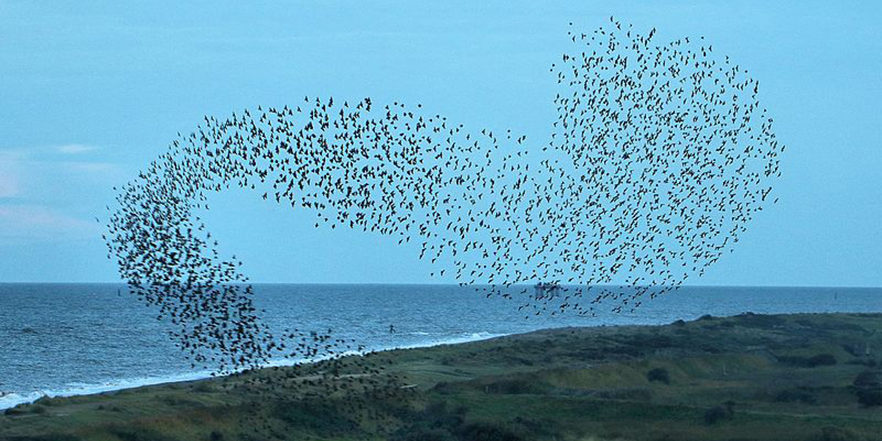Have you ever been awed by the balletic panorama of starlings flying in vast, undulating, geometric patterns across the sky (https://www.youtube.com/watch?v=KnndQgIUraQ)?
These astounding acrobatic formations are called “murmurations,” when hundreds or even thousands of starlings create dynamic, swooping, intricately coordinated patterns, formed over the flocks’ communal roosting site. Among other purposes, their unchoreographed ballet serves as mutual protection from predators like peregrine falcons, but we have yet to learn all the intricacies of their coordinated flight patterns. Mechanical and aerospace engineer George F. Young and his colleagues highlighted the point that such magnificent group cohesion is attained in a murmuration by the careful attunement of discrete units of seven starlings, aligned at a profoundly inter-connected level with the whole (“Starling Flock Networks Manage Uncertainty in Consensus at Low Cost,” PLOS Computational Biology; https://journals.plos.org/ploscompbiol/article?id=10.1371/journal.pcbi.1002894).
Starlings have a “remarkable ability to maintain cohesion as a group in highly uncertain environments and with limited, noisy information … Going in, Young et al. already knew that starlings pay attention to a fixed number of their neighbors in the flock, regardless of flock density—seven, to be exact. Their new contribution was to figure out that ‘when uncertainty in sensing is present, interacting with six or seven neighbors optimizes the balance between group cohesiveness and individual effort'” (https://www.npr.org/sections/13.7/2017/01/04/506400719/video-swooping-starlings-in-murmuration).
According to Emmanuel Hermellin and Fabien Michel:
“Every starling has an equivalent status in the flock and there is no leader deciding how the murmuration evolves.” Individual “agents” respond to the rhythms and pattern of the whole, adapting speed and course direction based on its proximity to the nearest neighbors, and with reference to a group fixed point.
“So, the behavioral model of an agent only relies on evolving the speed and the heading according to its local neighbors. To this end, the proximity with local neighbors is first tested and then Reynolds’s rules are triggered accordingly. More specifically, if there is no agent around then it continues to move in the same direction. Otherwise, the agent checks if the neighbors are not too close. Depending on the proximity between entities, agents separate (R.1), align with other entities or create cohesion. Then agents adapt their speed and move. The global behavior process for each entity is divided into three behaviors. 1) Separation: When an agent is too close from another one, it separates. This behavior consists in retrieving the heading of both agents. If these two directions lead to a collision, agent rotates to avoid its neighbor. 2) Align: When an agent comes closer to others, it tries to align itself with them, by adjusting his direction according to its nearest neighbor. Cohesion: When multiple agents are close without having to separate, each agent retrieves the directions of is neighbors and adjusts its own heading based on the average direction computed within its field of view. 3) Speed Adaptation: During all the simulation, every agent modifies its speed according to that of its neighbors.”
—Emmanuel Hermellin and Fabien Michel, “Complex Flocking Dynamics Without Global Stimulus,” MIT conference paper, Lyon, France, 2017; http://cognet.mit.edu/proceed/10.7551/ecal_a_083
A little biomimicry might go a long, long way for what ails the human family. For many decades, humanity has been suffering the deleterious effects of rampant individualism, static hierarchies, and toxic power-grabs for natural resources that are perceived as commodities to be plundered and exhausted at will. For an Earth in peril, what we need now is a murmuration, an intense connection with mini-pods of collaborators who fly so closely attuned they can sense subtle shifts of the inter-connected whole, the wider “We.” These “presencing pods” (ala U Theory) can help move us outside our ego-centric and anthropocentric myopia and into the magnificent and exhilarating movement of the whole swirling, undulating complex of life that is the biosphere. We have to become quieter. We have to pay attention. We have to find a fixed point of reference, like the common good, or our rooting place, Earth, to keep us all together. We have to go with the flow, only shifting when a critical mass is shifting, separating when necessary, avoiding collision by separation, and aligning with the nearest neighbors to maintain appropriate speed and distance. Moving too fast or too slow apart from the flock and not in proper proximity will have disastrous effects, while flying just at the right distance and speed—not too close and not too far—not too slow and not too fast, is paramount.
- How might we pay attention, listen and learn from our avian-kin in co-creating our own kind of mimetic murmuration, in imitation of their flight?
- What do starlings know and what disciplines do they practice that could help us human-kin be better as part of a larger whole?
- If we were to become profoundly attuned to seven wise ones, our most valued teachers and most collaborative innovators, including our other-than-human-kin, who might they be?
- How might we keep flying in fuller, more complex union with the wider “We?”
—Laura Weber, Prairiewoods associate director and retreats coordinator


